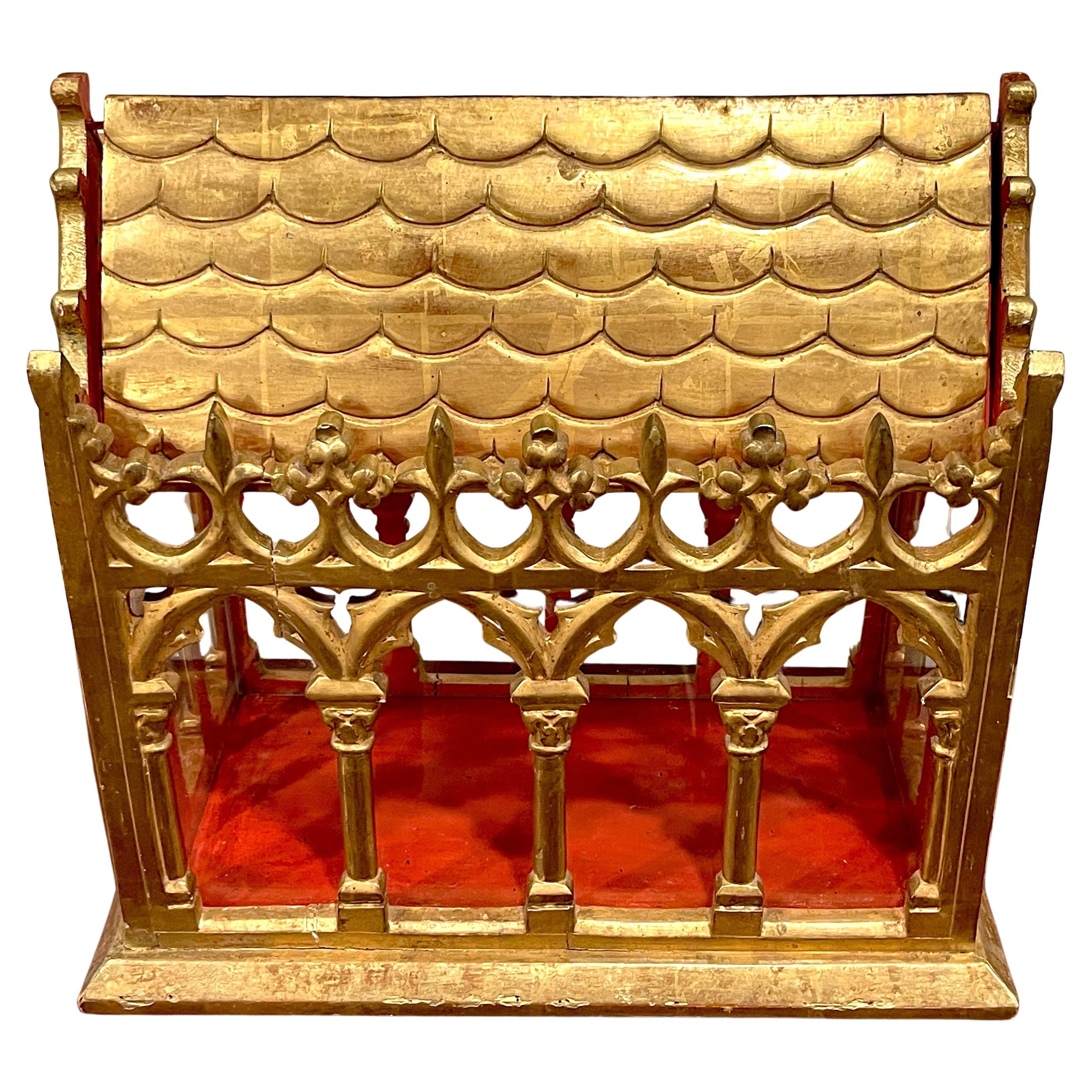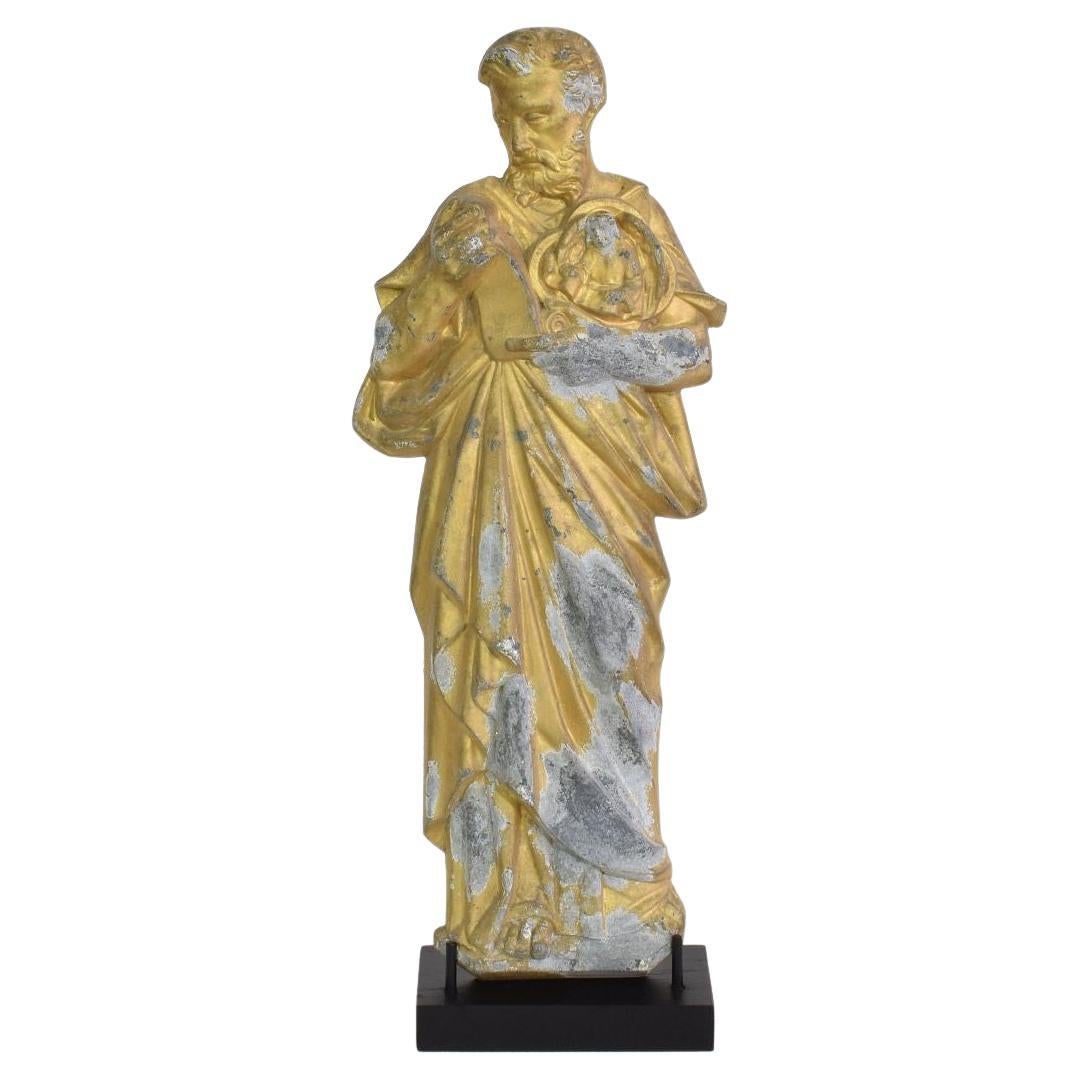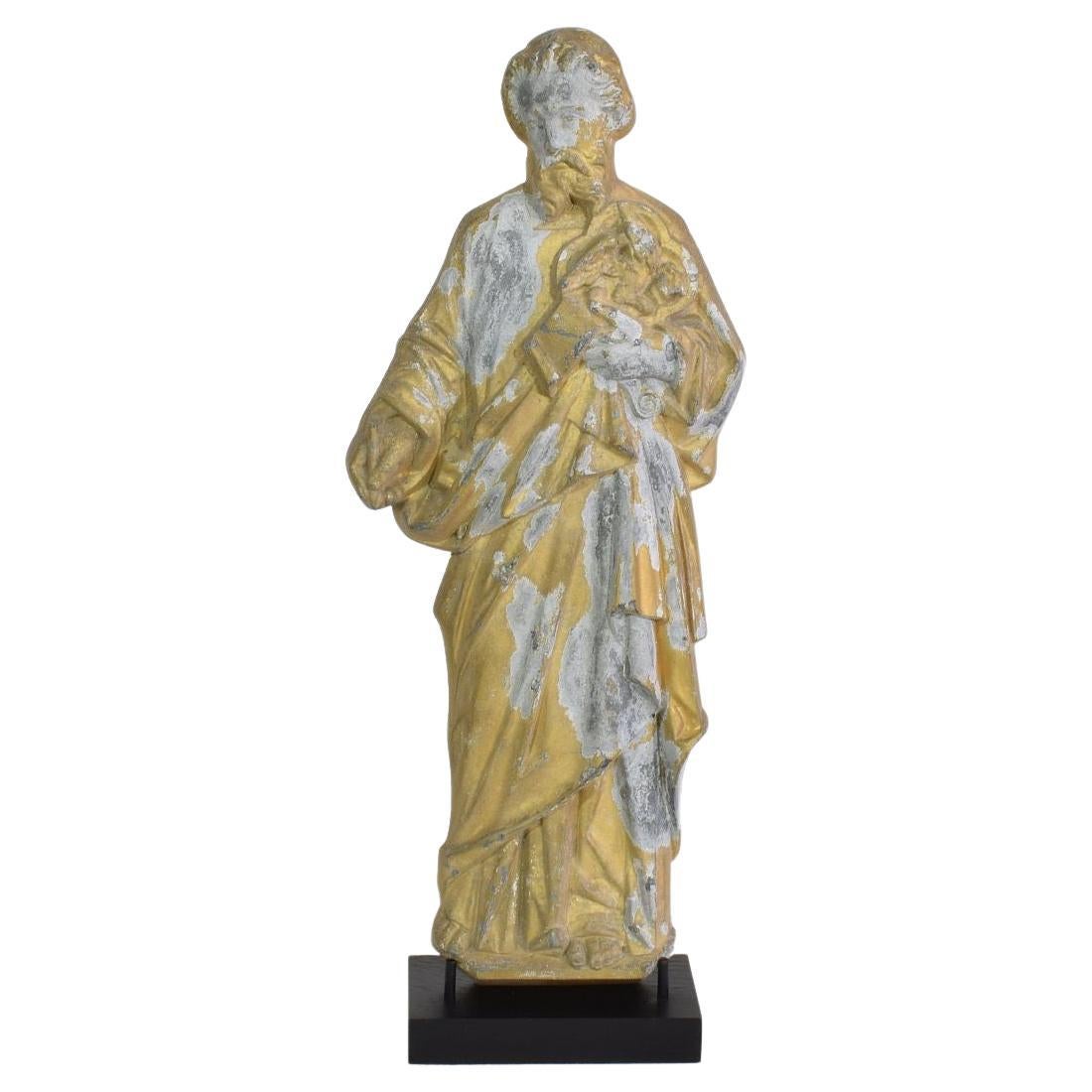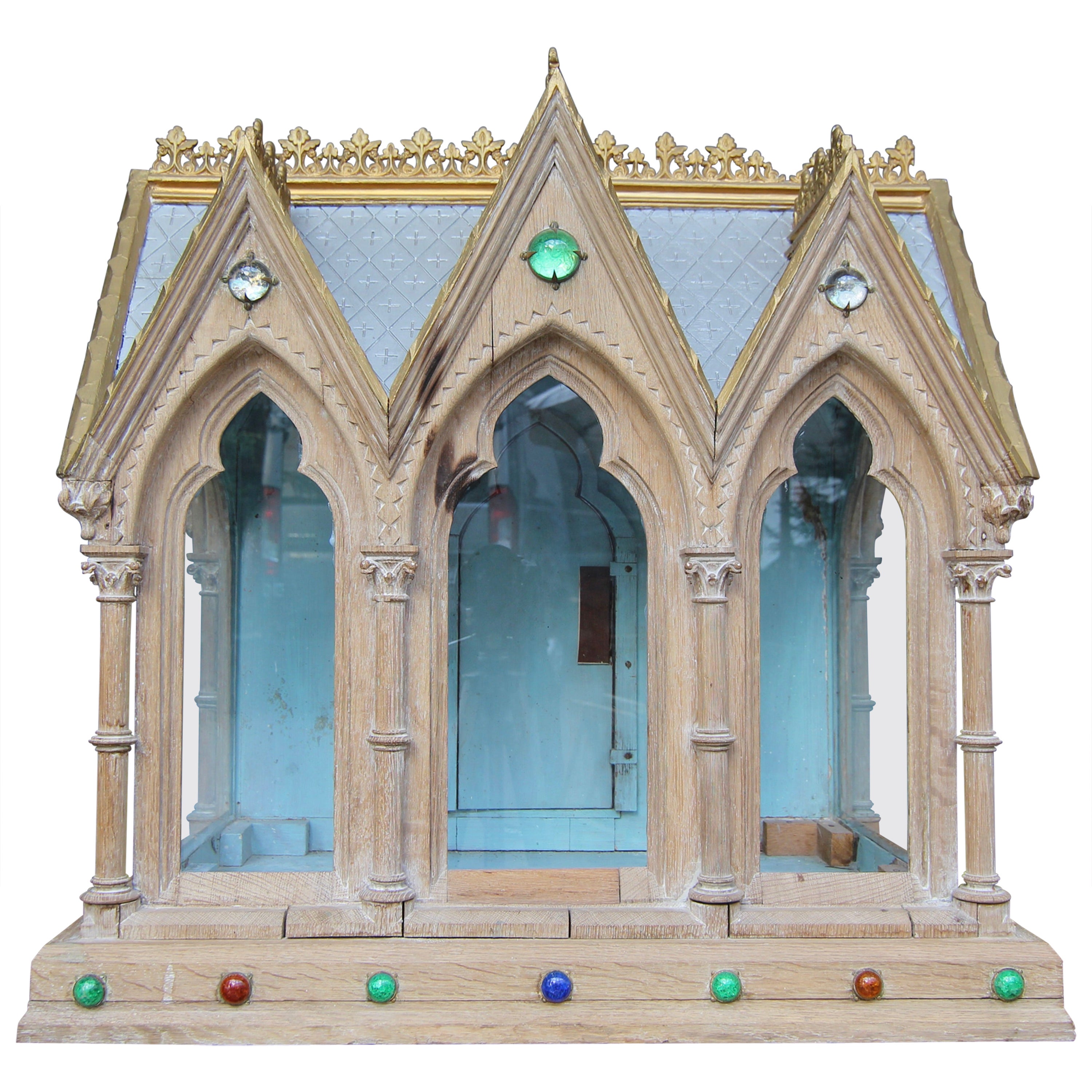Items Similar to Fine 19th Century French Neo-Gothic Gilt Metal Cathedral Church Reliquary Pair
Want more images or videos?
Request additional images or videos from the seller
1 of 21
Fine 19th Century French Neo-Gothic Gilt Metal Cathedral Church Reliquary Pair
About the Item
A stunning pair of very fine quality French Neo-Gothic gilt metal church reliquaries. circa 1860s
Most impressive objets d’art, born in France in the second half of the 19th century, most likely Parisian gilded bronze and brass ormolu work, exceptionally executed sculptural form, the exquisitely detailed architectural cathedral shaped case having a removable pointed steeple roof with cross finial, opening to relic display case surrounded on all sides by original glazed glass panes, stepped base, rising on disc feet. Signed, stamped by maker / bronzier "BC" (unknown) model "5096" and other faint marks to lid interiors.
Additional photos available upon request
Dimensions: (approx)
14.75" High, 6.75" Wide, 6.75" Deep; 13.25 lbs total
History:
A reliquary (also referred to as a shrine, by the French term châsse or monstrance) is a container for important religious relics.
The earliest reliquaries were essentially boxes, either simply box-shaped or based on an architectural design, taking the form of a model of a church with a pitched roof. These latter are known by the French term chasse, and typical examples from the 12th to 14th century have wooden frameworks with gilt-copper plaques nailed on, decorated in champlevé enamel. Limoges was the largest production centre; NB the English usage differs from that of the French châsse, which denotes large size rather than shape.
Relics of the True Cross became very popular from the 9th century onward and were housed in magnificent gold and silver cross-shaped reliquaries decorated with enamels and precious stones. From about the end of the 10th century, reliquaries in the shape of the relics they housed also became popular; hence, for instance, the skull of Pope Alexander I was housed in a head-shaped reliquary. Similarly, the bones of saints were often housed in reliquaries that recalled the shape of the original body part, such as an arm or a foot.
A philatory is a transparent reliquary designed to contain and exhibit the bones and relics of saints. This style of reliquary has a viewing portal to view the relic inside. The feretrum was a medieval form of reliquary or shrine containing the sacred effigies and relics of a saint.
During the later Middle Ages, the monstrance form, primarily used for consecrated hosts, was sometimes used for reliquaries. These housed the relic in a rock crystal, or glass capsule mounted on a column above a base, enabling the relic to be displayed to the faithful. Reliquaries in the form of large pieces of metalwork jewellery also appeared around this time, housing tiny relics such as pieces of the Holy Thorn, notably the Holy Thorn Reliquary now in the British Museum.
Condition:
Superb museum quality examples, in excellent original unrestored antique condition with beautifully aged patina. Wear consistent with age and use. Heavily patinated - scattered oxidation. Overall wonderful examples.
Typically reliquaries were not sold in pairs, so to find a matching pair such as this is exceptionally rare.
Worldwide shipping available
Local pickup available near Dallas, Texas
Additional:
We here at Lynx Hollow Antiques love religious antiques, from Christian tabernacles, Catholic altarpiece, life-size Buddhist temple sculptures, Hindu votive offerings, 16th century Islamic mosque architectural salvaged windows, we have a large selection to choose from. Also including Spanish Colonial santo figure carvings, primitive Mexican folk art, hand-painted retablo, reredos, icons, liturgical cabinets, monastery tables, religious home decor, and more. Be sure to checkout our other listings.
- Dimensions:Height: 14.75 in (37.47 cm)Width: 6.75 in (17.15 cm)Depth: 6.75 in (17.15 cm)
- Sold As:Set of 2
- Style:Gothic Revival (Of the Period)
- Materials and Techniques:
- Place of Origin:
- Period:
- Date of Manufacture:circa 1860s
- Condition:Wear consistent with age and use. Superb museum quality examples, in excellent original unrestored antique condition with beautifully aged patina. Wear consistent with age and use. Heavily patinated - scattered oxidation. Overall wonderful examples.
- Seller Location:Forney, TX
- Reference Number:1stDibs: LU5977235578342
About the Seller
4.8
Platinum Seller
These expertly vetted sellers are 1stDibs' most experienced sellers and are rated highest by our customers.
Established in 2013
1stDibs seller since 2021
200 sales on 1stDibs
Typical response time: <1 hour
- ShippingRetrieving quote...Ships From: Forney, TX
- Return PolicyA return for this item may be initiated within 7 days of delivery.
More From This SellerView All
- 19th Century American Neo-Gothic Oak Church Altar Temple Lectern Book StandLocated in Forney, TXA monumental antique Victorian Gothic Revival carved oak church altar / synagogue lectern / book stand podium. Hand-crafted in the 19th century, having a sloped book-rest to the top...Category
Antique 19th Century North American Gothic Revival Religious Items
MaterialsOak
- 19th Century French Neo-Gothic Carved Oak Hall Bench CabinetLocated in Forney, TXA scarce antique Gothic Revival French hand-carved oak hall bench with original nicely aged dark warm rich patina. circa 1870 Hand-crafted in France in the late 19th century, high-quality solid wood construction, rare form, having a tall double-door cabinet with carved tracery panels, iron slide bolt...Category
Antique Late 19th Century French Gothic Revival Benches
MaterialsOak
- 19th Century French Ecclesiastical Iron & Bronze Altar RailLocated in Forney, TXA rare and magnificent architectural ecclesiastical iron and bronze altar railing. Created in France in the 19th century, commissioned for a Victorian er...Category
Antique 19th Century French Gothic Revival Religious Items
MaterialsBronze, Iron
- Fine 19th Century European Gilt Bronze Ormolu Monstrance ReliquaryLocated in Forney, TXA scarce fine quality neoclassical Empire style vasiform gilt bronze ormolu church religious relic altar monstrance reliquary. Exquisitely hand-crafted in Continental Europe in the second half of the 19th century, most likely French Napoleon III Period (1852-1870), having a fanned cross crest, above winged angel mask, central oval display...Category
Antique 19th Century European Empire Sculptures and Carvings
MaterialsBronze, Ormolu
- Monumental 19th Century Dutch Church Painted Wood CrossLocated in Forney, TXA massive nearly 10 foot tall by 5.5 foot wide antique Dutch ecclesiastical wooden cross. Hand-crafted in the Netherlands in the 19th century, very large sculptural Celtic cross for...Category
Antique 19th Century Dutch Folk Art Religious Items
MaterialsIron
- 19th Century French Gothic Revival Carved Bibliothèque BookcaseLocated in Forney, TXA magnificent 19th century Gothic Revival hand carved painted parcel gilt bibliothèque (bookcase - buffet - china cabinet). Born in France, circa 1840, most impressive size, two-...Category
Antique 19th Century French Gothic Revival Bookcases
MaterialsGlass, Wood, Paint
You May Also Like
- 19th Century French Gothic Cathedral Giltwood & Glass Reliquary / VitrineLocated in West Palm Beach, FL19th Century French gothic cathedral giltwood & glass reliquary / vitrine France, mid-19th century. A reliquary is a container for the display an...Category
Mid-20th Century French Gothic Revival Religious Items
MaterialsGlass, Giltwood
- French Late 19th Century Neo Gothic Gilded Metal Saint StatueLocated in Buisson, FRWonderful gilded metal saint statue with beautiful expression, France, circa 1880-1900. Weathered. Measurements include the wooden base.Category
Antique Late 19th Century French Gothic Revival Religious Items
MaterialsMetal
- French Late 19th Century Neo Gothic Gilded Metal Saint StatueLocated in Buisson, FRWonderful gilded metal saint statue with beautiful expression. France, circa 1880-1900. Weathered. Measurements include the wooden base.Category
Antique Late 19th Century French Gothic Revival Figurative Sculptures
MaterialsMetal
- Late 19th Century Gothic Revival Reliquary CasketLocated in Dusseldorf, DEA Gothic Revival reliquary. Circa late 19th / early 20th century. Made of solid oak with fine carving. Reliquaries have been used to store relics since the Middle Ages. In sacred architecture they are often located behind the main altar in the chancel. In addition to classical, often church-like caskets, anthropomorphic, so-called "speaking" reliquaries were also made, which already inform the viewer about their contents through their own design. Mostly they were made of precious metals and decorated with rich sculptural ornaments or precious stones. One of the most famous examples of reliquaries is the Epiphany shrine of Nicholas of Verdun from the late 12th or early 13th century in Cologne Cathedral. The reliquary offered here has an architectural structure with a rectangular ground plan. The three-sided glazed box with a dormer roof rests on a plinth. A total of 8 columns of Corinthian order form the arcades which are crowned on both long sides by 3 lancets each and enclose the lancet windows...Category
Antique Late 19th Century German Gothic Revival Religious Items
MaterialsGlass, Oak
- Neo-Gothic 19th Century Octagonal Pedestal / Stand / Architectural ModelLocated in Troy, NYAn unusual pedestal of octagonal Neo-Gothic form, the molded base supporting eight shaped and carved columns decorated with typical Gothic designs, topped by eight spikes surrounding...Category
Antique Mid-19th Century English Gothic Revival Pedestals
MaterialsOak
- 19th Century French Gothic Sacrament CabinetLocated in Dallas, TX19th Century French Gothic Sacrament cabinet was artfully sculpted from solid oak and fruitwood to create a remarkable religious artifact designed to be appreciated throughout the ages! The trapezoidal form of the casework is in keeping with the Gothic style, which historians concur originated in the Cathedral of St. Denis during the middle of the 12th century. Boldly molded crown follows the complex contours and overlooks the case below which features a single door flanked by cornerposts that feature pilasters facing front as well as the sides, with recessed arched panels topped with recessed circular frames above filled with carved rosettes highlighted in gold. The arched recesses facing the front are also filled with carved floral and wheat motifs also highlighted in gold, representing the Bread of Life. The door panel, however, steals the show, with a gloriously carved relief work depicting both wheat and fully laden grapevines adding the significance of the Blood of Christ...Category
Antique Mid-19th Century French Gothic Revival Religious Items
MaterialsFruitwood, Oak
Recently Viewed
View AllMore Ways To Browse
Gilted Gothic French
Crystal Box With Ormolu
16th Century Gothic Metal
Primitive Stone Head
Islamic Brass Sculptures
Silver Monstrance
Primitive Mexican Cabinet
Used Religious Items
Catholic Relics
Reliquary Shrine
Antique Catholic Relics
Spanish Monastery Table
Spanish Colonial Reliquary
Mid Century Limoges
Antique Catholic Jewelry
Antique French Wooden Jewelry Box
Sacred Jewelry Icon
Large Retablo





